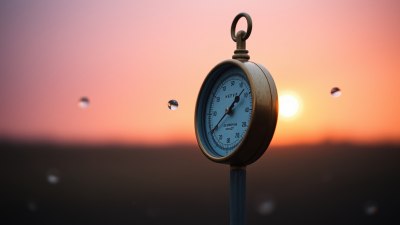Barometric Pressure Drops - And So Does Your Chill
Explore how falling barometric pressure affects your body and mood, explaining the science behind weather changes and your mental state.

Barometric pressure, also known as atmospheric pressure, is the force exerted by the weight of air in the Earth's atmosphere. It plays a crucial role in weather patterns and can significantly impact human physiology and psychology. When barometric pressure drops, it often signals an approaching storm or weather change, but it also can influence how you feel physically and emotionally. This article delves into the science behind barometric pressure fluctuations and why drops in pressure might cause your mood to chill or your wellbeing to dip.
Understanding Barometric Pressure
Barometric pressure is measured using a device called a barometer, typically recorded in units of millibars (mb) or inches of mercury (inHg). At sea level, the average atmospheric pressure is about 1013.25 mb or 29.92 inHg. However, this value fluctuates as weather systems move, often declining ahead of low-pressure systems and rising with high-pressure systems.
Low pressure means there is less air above a given point, which often correlates with stormy or rainy weather, while high pressure usually indicates clearer, calmer conditions. These changes in pressure aren't just abstract numbers; they translate into physical forces acting upon your body. The air pressure outside your body pushes inward, and when that external pressure drops, the relative internal pressure in your body increases slightly, creating biological effects.
How Drops in Barometric Pressure Affect Your Body
The human body is sensitive to changes in the environment, including fluctuations in air pressure. One key area affected is the sinuses. Lower pressure outside the body means the air inside your sinus cavities is at a higher pressure, causing discomfort, headaches, or sinus pain for some individuals. This is why people with sinus problems often report worsening symptoms when storms are approaching.
Joint pain sufferers, especially those with arthritis, might also notice increased discomfort during low-pressure weather changes. Research suggests that when the barometric pressure drops, the pressure on joints and tissues may be reduced, leading to swelling or inflammation that causes pain. While scientific studies vary in conclusiveness, many individuals claim a stark correlation between their joint pain and weather changes.
Mental and Emotional Effects of Low Barometric Pressure
Beyond physical symptoms, changes in barometric pressure can influence your mood and cognitive state. Many people report feeling more lethargic, irritable, or down when pressure drops. Several theories seek to explain this phenomenon. One centers on the decreased availability of oxygen as low-pressure systems approach, which might subtly impact brain function, leading to feelings of fatigue or reduced alertness.
Another explanation involves the interaction between barometric pressure and neurotransmitter activity. Low pressure may alter serotonin levels, a critical chemical in regulating mood. Variations in serotonin can affect anxiety, depression, and general emotional balance, leading to an increase in negative feelings or decreased motivation during low-pressure weather events.
Scientific Research on Barometric Pressure and Human Behavior
Studies have explored the links between atmospheric pressure changes and human psychological states with varied results. Some research indicates that drops in barometric pressure correlate with increases in hospital admissions for mood disorders, while other studies find no direct causation. However, observational evidence supports that many individuals experience mood shifts aligned with weather changes, including pressure drops.
One notable study observed patterns of increased depressive symptoms and irritability preceding storms, linked with decreases in barometric pressure. The researchers hypothesized that pressure drops may disrupt the circadian rhythms and hormonal balances critical to mood regulation. This disruption can manifest as increased sensitivity to stress or emotional instability during weather changes.
Physiological Mechanisms Behind Weather-Related Mood Changes
The body's internal clock, centered in the suprachiasmatic nucleus of the brain, regulates sleep-wake cycles, hormone release, and mood. Environmental cues such as light, temperature, and atmospheric pressure help synchronize these rhythms. A falling barometric pressure may signal an imminent weather change, triggering subtle physiological responses preparing the organism for altered conditions.
Such responses can include modulation of cortisol levels, the body's primary stress hormone. Decreases in pressure might cause abnormal cortisol fluctuations, contributing to changes in energy levels and mood. Additionally, changes in pressure could influence melatonin secretion, affecting sleep quality and daytime alertness, thereby impacting overall emotional wellbeing.
Impact on Sleep and Energy Levels
Many individuals report poor sleep quality or increased fatigue correlating with weather disturbances caused by dropping barometric pressure. The interaction between pressure changes and the body's biological rhythms can disrupt normal sleep patterns, leading to tiredness and decreased cognitive function. This fatigue can further exacerbate feelings of irritability and lowered mood.
Moreover, these physical sensations are often compounded by reduced outdoor activity during poor weather, diminishing exposure to sunlight and physical exercise, both of which are integral to maintaining mental health. The resulting sedentary habits intensify the psychological effects of pressure drops.
Barometric Pressure and Headaches or Migraines
Another well-documented consequence of decreasing barometric pressure is its effect on headaches and migraines. Many migraine sufferers report that low-pressure weather triggers attacks or intensifies symptoms. The exact cause remains complex, but prevailing theories suggest that atmospheric pressure changes affect blood flow and oxygenation in the brain, contributing to headache onset.
Fluctuations in barometric pressure can cause blood vessels to dilate or constrict, influencing pain perception. Additionally, pressure changes might impact neurochemical balances responsible for triggering migraine cascades. Identifying barometric pressure drops as a possible migraine trigger can guide sufferers in managing their condition by tracking weather changes.
Techniques to Cope With Low Barometric Pressure Effects
While you cannot control the weather, several strategies can minimize the impact of falling barometric pressure on your wellbeing. For physical symptoms like joint pain or headaches, maintaining proper hydration and using anti-inflammatory medications as directed may provide relief. For sinus-related discomfort, nasal irrigation or decongestants can alleviate pressure buildup.
Addressing the mental and emotional effects involves lifestyle adjustments. Prioritize regular exercise, which boosts serotonin and endorphin levels, counteracting low mood. Exposure to natural light, even on overcast days, helps regulate circadian rhythms. Additionally, mindfulness meditation and stress management techniques can support emotional resilience during weather-induced mood fluctuations.
When to Seek Medical Advice
If symptoms related to barometric pressure drops become severe or interfere substantially with daily life, consulting a healthcare professional is advisable. Persistent headaches, worsening arthritis pain, or depressive symptoms warrant a thorough medical evaluation to rule out underlying conditions and develop appropriate treatment plans. Tracking symptoms along with weather data can assist healthcare providers in making accurate diagnoses.
Technological Tools to Track Barometric Pressure
Thanks to smartphones and wearable technology, it is easier than ever to monitor barometric pressure in real time. Many weather apps provide atmospheric pressure readings and alerts for significant changes. Individuals sensitive to pressure drops can use these tools to anticipate symptoms and prepare accordingly, adjusting activities or medications ahead of weather shifts.
Advanced devices such as electronic barometers and smartwatches measure atmospheric pressure precisely, offering additional data to support personal health management related to environmental conditions. Combining technological tracking with symptom journaling empowers individuals to better understand their responses and improve quality of life.
Environmental and Ecological Implications of Barometric Pressure Changes
Beyond human effects, barometric pressure drops influence animal behavior, plant physiology, and ecological systems. Many animals sense pressure changes and alter their activities accordingly, such as birds adjusting flight patterns or marine creatures changing depth. These biological responses reflect evolutionary adaptation to atmospheric conditions, underscoring how deeply pressure affects living organisms.
Understanding these natural responses provides insight into the interconnectedness of weather, pressure, and life on Earth. It also highlights potential considerations for monitoring environmental changes in response to climate variability.
Summary of Connections Between Barometric Pressure and Wellbeing
A drop in barometric pressure is more than a meteorological occurrence; it impacts physical comfort, psychological state, and overall wellbeing. While the exact mechanisms continue to be researched, existing evidence supports the idea that external atmospheric pressure affects internal bodily functions, mood regulation, pain sensitivity, and energy levels. Awareness and management strategies can help mitigate adverse reactions, allowing individuals to maintain health despite nature’s fluctuations.
As science advances, deeper understanding of barometric pressure’s role could contribute to enhanced medical treatments and improved personal health tracking. Meanwhile, being attuned to the weather and its effects on your body remains a practical and empowering step toward holistic wellness.











